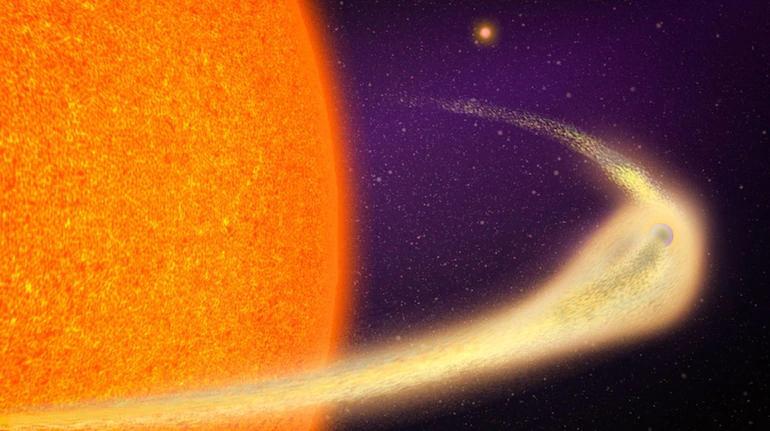
Dying Planet Producing 9 mn km-long Comet-like Tail: Astronomers
In a fascinating discovery, astronomers at Massachusetts Institute of Technology (MIT) have identified a rocky planet that is slowly disintegrating as it orbits close to its star. The planet, dubbed BD+05 4868 Ab, is located about 140 light-years away from Earth and is shedding its outer layer, leaving behind a massive comet-like tail of dust.
The team of researchers, led by Dr. Laura Kreidberg, used the Spitzer Space Telescope and the Hubble Space Telescope to study the planet’s behavior. The observations revealed that the planet is gradually losing its outer layer due to intense heat and radiation from its nearby star. This process, known as evaporation, is causing the planet’s atmosphere to slowly disperse into space.
What’s remarkable about this discovery is the sheer scale of the comet-like tail being produced by the dying planet. The tail, which is estimated to be around 9 million kilometers long, is made up of tiny particles of dust and gas that are being ejected into space as the planet’s atmosphere evaporates.
“This is an extraordinary object, and it’s giving us a unique opportunity to study the final stages of a planet’s life,” said Dr. Kreidberg, lead author of the study. “We’re seeing a planet that’s being torn apart by its star, and it’s leaving behind a trail of debris that we can observe in incredible detail.”
The discovery of BD+05 4868 Ab provides scientists with a rare glimpse into the final stages of a planet’s life. As the planet continues to evaporate, it will eventually disintegrate into a cloud of dust and gas, leaving behind a faint remnant of its former self.
“This is a really exciting find because it shows us that planets can have a long and complex life, even if they’re not actively forming new planets,” said Dr. Kreidberg. “We’re seeing a planet that’s been around for billions of years, and it’s finally reaching the end of its life.”
The study of BD+05 4868 Ab also offers scientists insights into the formation and evolution of planetary systems. By studying the planet’s composition and behavior, researchers can gain a better understanding of how planets form and evolve over time.
“This discovery is a reminder that there’s still so much we don’t know about the universe, and that there are still many mysteries to be solved,” said Dr. Kreidberg. “By studying objects like this, we’re not only gaining a deeper understanding of the universe, but we’re also pushing the boundaries of what we thought was possible.”
The study of BD+05 4868 Ab has significant implications for the search for life beyond Earth. By studying the conditions under which planets form and evolve, scientists can gain a better understanding of the likelihood of finding life elsewhere in the universe.
“This discovery is a reminder that the search for life beyond Earth is an ongoing effort, and that there are still many unknowns to be uncovered,” said Dr. Kreidberg. “By studying objects like this, we’re not only gaining a deeper understanding of the universe, but we’re also taking a step closer to understanding our place in the universe.”
In conclusion, the discovery of BD+05 4868 Ab is a remarkable find that offers scientists a unique glimpse into the final stages of a planet’s life. The comet-like tail of dust and gas being produced by the dying planet is a testament to the incredible complexity and beauty of the universe.
As scientists continue to study this remarkable object, they are gaining valuable insights into the formation and evolution of planetary systems. By pushing the boundaries of what we thought was possible, researchers are taking a step closer to understanding the mysteries of the universe.
Source:






